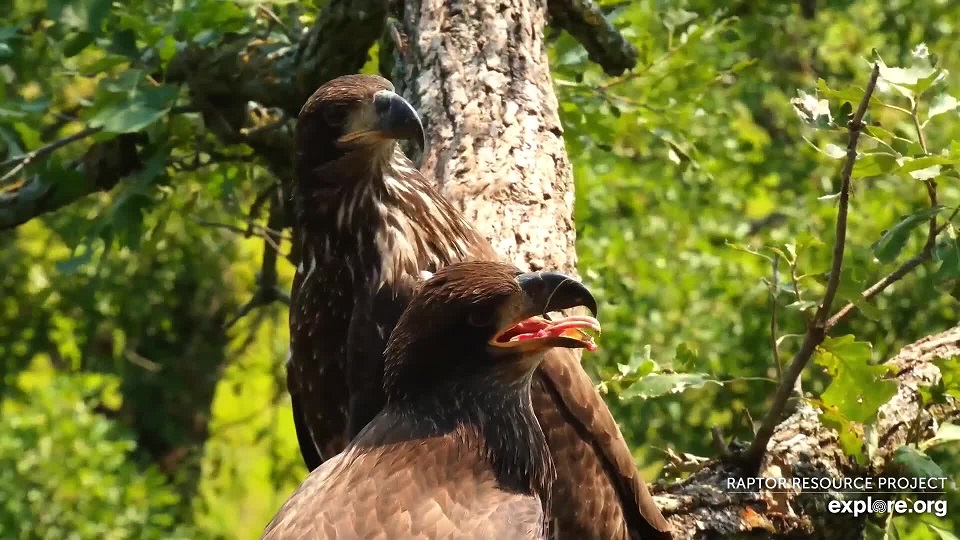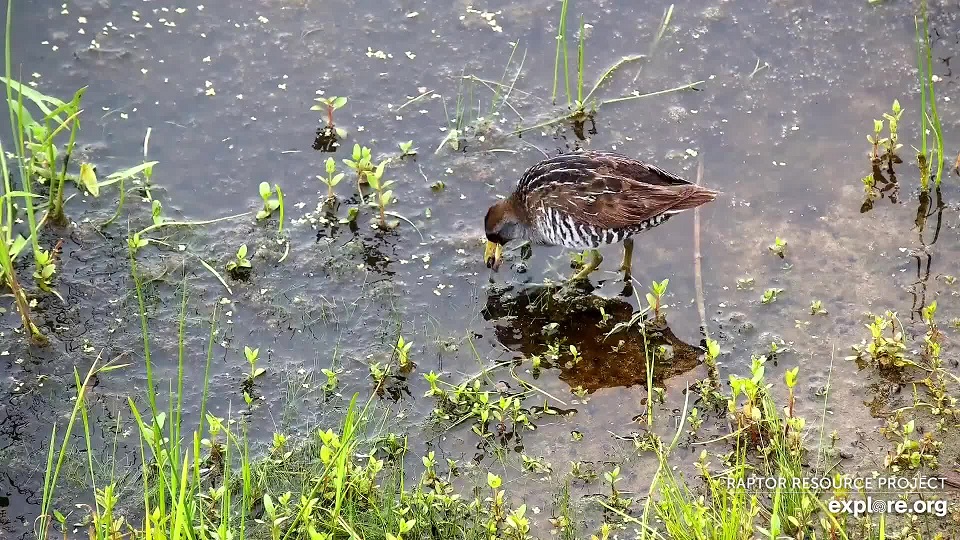From Chance’s first few falcon flights through family portraits at Decorah North and extremely cool water birds on the Mississippi Flyway, we have your mega-Nestflix roll – along with information about plumage, juvenile hunting skills, those plants at the North nest, and a really cute duckling. A thousand thanks to our camera operators and videomakers for catching and sharing these special moments with us. I hope you enjoy these videos as much as I did!
Great Spirit Bluff
July 20, 2021: Chance gets a meal on a branch – https://youtu.be/KahkAdmgiy8. I loved the look at Chance’s plumage in this video! Look at the images to compare her plumage with that of her two-year old mother and fully adult father. I also enjoyed seeing her mantle over her meal before she wolfed it down!
Will Zooey and Newman continue to care for Chance? They will – at least for a little bit. If we’re lucky, we’ll see tail-chases and aerial prey as Chance refines her flying skills in falcon flight school. How long will she stay? Dispersal times vary, but she’ll most likely disperse between mid-August and mid-September. We might see her on the Flyway as she expands her peregrinations and starts to explore her world.
July 19, 2021: Chance at rock perch and back to nest box – https://youtu.be/JsVFYOS4b3c. The video opens with Chance on the rock perch! Note her lovely brown plumage and heavily streaked breast. She won’t gain her adult plumage until her second year, although her cere and the flesh around her eyes might yellow by this fall. While we can’t Chance, she is clearly vocalizing as she checks the ledge out. After a really lovely close-up at 3:37 and a little more wingercizing, she flies off at 4:13, circling back to her nest box.
Newly fledged birds often struggle with basic tasks like taking off, landing, and soaring. It’s hard to slow down without stalling out, or stay steady in level flight. Chance is still learning how to use her wings, but she appears strong and confident as she takes off.
July 19, 2021: Chance return – https://youtu.be/PBPjupzd4aE. This was Chance’s first return to the nest box! Slow the video down and watch at around 8 seconds as she tries to land in the box. She misses the perch and briefly winds up between the rails, but quickly clambers up into the box. Even slowed down, her speed is impressive!
Note how much larger Chance looks when Zooey comes into the nest box with dinner. Although adults often weigh a little more than juveniles, juveniles have longer flight feathers. Shorter adult flight feathers provide more speed and maneuverability, while longer juvenile feathers aid lift and gliding. This makes it easier for new fliers to avoid stalling out and can make them appear very large next to adults.
Decorah Eagles North

July 19, 2021: DN13 and DN14 on the babysitting branch!
July 20, 2021: Juvenile plumage and talons – https://youtu.be/6Og6vySU4zY. Close-ups start at 1:43, followed by a lovely head study and plumage at 6:56. Note how DN14’s wings meet above the end of her long tail and don’t cross over. Her broad wings aren’t short, but they aren’t as long as a falcon’s wings. As the camera moves back up, we get a glimpse of her asymmetrical primaries. The leading edge is a lot smaller because primary feathers catch the wind and twist. Their stiff, asymmetrical form helps keep DN14 aloft and protects her feathers from breaking. You might be impressed by the talon close-up beginning at 9:30! DN14’s hallux claw is between 1.5 and 1.7 inches long: sharp, beautiful, and in excellent shape!
July 19, 2021: Decorah Eagles North fishdrop – https://youtu.be/AVGuYaYUgwU. Mr. North drops a fish off and gets out of the way!
Are DN13 and DN14 catching their own food yet? We don’t know, but we do know something about what fledglings tend to eat. Carrion can’t run away or fight, so it tends to be a popular option. We’ve also seen eaglets wade into streams to catch fish and searching the ground for rodents or large insects. Don’t worry if they don’t seem to be catching their own food – in general, adults are more likely to hunt and kill while juveniles and subadults are more reliant on scavenging, piracy, and kleptoparasitism to get their daily meal.
July 18, 2021: Family get together, big bird flyover – https://youtu.be/s0x6zDGAP8A. Mr. North and the eaglets perch side by side on a snag. It’s nice to see them together – and even nicer that Mr. North doesn’t need to watch his talons! Slow down at 16:36 to watch an excellent flyout. Someone just aced their takeoff test!
What is that plant in the background? It is wild hemp! You can learn more about it here: https://www.raptorresource.org/2019/06/02/what-are-those-weeds-growing-in-the-decorah-north-nest/
Mississippi Flyway

July 14, 2021: A Sora on the Flyway
July 18, 2021: Dowitcher – https://youtu.be/2sFVXTRkl1o. Check out this cool shorebird with its long, long beak! Dowitchers feed by probing deeply into wet, muddy or sandy substrate for invertebrates, using their long, sensitive beaks to find prey.
July 14, 2021: Sora – https://youtu.be/1VEPIwc3TDE. Another cool shore bird! Its body is somewhat similar to a Dowitcher’s body, but its beak is very different! Where Dowitchers probe mud and sand to find hidden invertebrates, Sora peck at the water’s surface for seeds and invertebrates. See those long, long toes? Sora rake floating vegetation with their long toes in search of sedge, bulrush, grass, rice, and smartweed seeds.
We’re seeing a few birds that I wouldn’t expect to see for another two weeks or so. I wonder if drought isn’t driving them into the river valley a little earlier than usual. Thanks to everyone who captures video and snapshots – it really helps us develop phenological data on nesting, dispersal, and appearance.
July 13, 2021: Close-up duckling! https://youtu.be/DzbO08G8g4Q. Just an adorable duckling hiding in the long grass. If you like ducklings as much as I do, this video is for you!
 The Raptor Resource Project
The Raptor Resource Project The Raptor Resource Project
The Raptor Resource Project